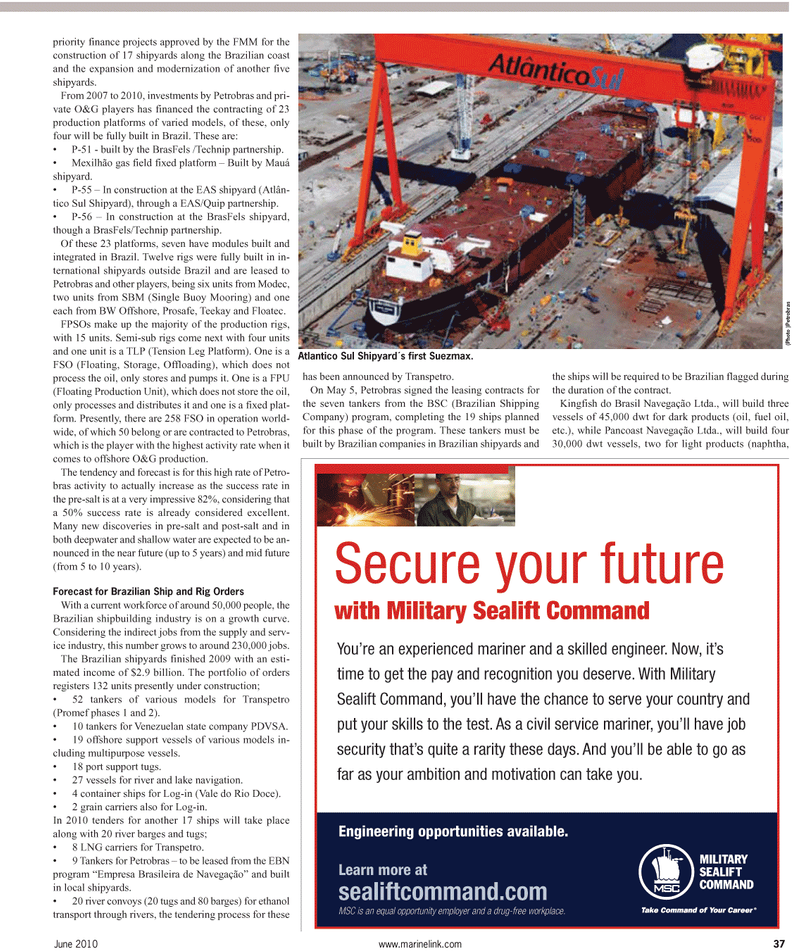
Page 37: of Maritime Reporter Magazine (June 2, 2010)
Read this page in Pdf, Flash or Html5 edition of June 2, 2010 Maritime Reporter Magazine
June 2010 www.marinelink.com 37 priority finance projects approved by the FMM for the construction of 17 shipyards along the Brazilian coast and the expansion and modernization of another five shipyards.
From 2007 to 2010, investments by Petrobras and pri- vate O&G players has financed the contracting of 23 production platforms of varied models, of these, only four will be fully built in Brazil. These are: • P-51 - built by the BrasFels /Technip partnership. • Mexilhão gas field fixed platform – Built by Mauá shipyard. • P-55 – In construction at the EAS shipyard (Atlân- tico Sul Shipyard), through a EAS/Quip partnership. • P-56 – In construction at the BrasFels shipyard, though a BrasFels/Technip partnership.
Of these 23 platforms, seven have modules built and integrated in Brazil. Twelve rigs were fully built in in- ternational shipyards outside Brazil and are leased to
Petrobras and other players, being six units from Modec, two units from SBM (Single Buoy Mooring) and one each from BW Offshore, Prosafe, Teekay and Floatec.
FPSOs make up the majority of the production rigs, with 15 units. Semi-sub rigs come next with four units and one unit is a TLP (Tension Leg Platform). One is a
FSO (Floating, Storage, Offloading), which does not process the oil, only stores and pumps it. One is a FPU (Floating Production Unit), which does not store the oil, only processes and distributes it and one is a fixed plat- form. Presently, there are 258 FSO in operation world- wide, of which 50 belong or are contracted to Petrobras, which is the player with the highest activity rate when it comes to offshore O&G production.
The tendency and forecast is for this high rate of Petro- bras activity to actually increase as the success rate in the pre-salt is at a very impressive 82%, considering that a 50% success rate is already considered excellent.
Many new discoveries in pre-salt and post-salt and in both deepwater and shallow water are expected to be an- nounced in the near future (up to 5 years) and mid future (from 5 to 10 years).
Forecast for Brazilian Ship and Rig Orders
With a current workforce of around 50,000 people, the
Brazilian shipbuilding industry is on a growth curve.
Considering the indirect jobs from the supply and serv- ice industry, this number grows to around 230,000 jobs.
The Brazilian shipyards finished 2009 with an esti- mated income of $2.9 billion. The portfolio of orders registers 132 units presently under construction; • 52 tankers of various models for Transpetro (Promef phases 1 and 2). • 10 tankers for Venezuelan state company PDVSA. • 19 offshore support vessels of various models in- cluding multipurpose vessels. • 18 port support tugs. • 27 vessels for river and lake navigation. • 4 container ships for Log-in (Vale do Rio Doce). • 2 grain carriers also for Log-in.
In 2010 tenders for another 17 ships will take place along with 20 river barges and tugs; • 8 LNG carriers for Transpetro. • 9 Tankers for Petrobras – to be leased from the EBN program “Empresa Brasileira de Navegação” and built in local shipyards. • 20 river convoys (20 tugs and 80 barges) for ethanol transport through rivers, the tendering process for these has been announced by Transpetro.
On May 5, Petrobras signed the leasing contracts for the seven tankers from the BSC (Brazilian Shipping
Company) program, completing the 19 ships planned for this phase of the program. These tankers must be built by Brazilian companies in Brazilian shipyards and the ships will be required to be Brazilian flagged during the duration of the contract.
Kingfish do Brasil Navegação Ltda., will build three vessels of 45,000 dwt for dark products (oil, fuel oil, etc.), while Pancoast Navegação Ltda., will build four 30,000 dwt vessels, two for light products (naphtha,
Engineering opportunities available.
Learn more at sealiftcommand.com
MSC is an equal opportunity employer and a drug-free workplace.
Secure your future with Military Sealift Command
You’re an experienced mariner and a skilled engineer. Now, it’s time to get the pay and recognition you deserve. With Military
Sealift Command, you’ll have the chance to serve your country and put your skills to the test. As a civil service mariner, you’ll have job security that’s quite a rarity these days. And you’ll be able to go as far as your ambition and motivation can take you. (Photo )Petr obras
Atlantico Sul Shipyard´s first Suezmax.

 36
36

 38
38
